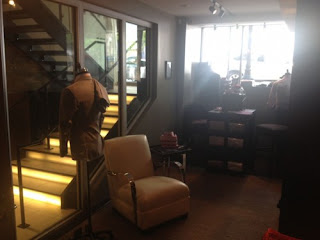After decades of neglect, the pocket square is back. In the past two years, many men have begun embracing the subtle touch of flash and style that a pocket square can provide. Some men choose to go simple, wearing a plain, shirt matching, pocket square folded straight, while others prefer the panache of a brightly colored elegantly folded square. Whatever your preferences, before adding a pocket square to your
wardrobe you will first need to find the right pocket squares and learn how to fold them.
Selecting the right pocket square can be difficult. Many men simply choose a white pocket square to match any basic shirt, however this can be more limiting than you might think. When wearing a simple elegant suit or tuxedo a colorful square might detract from the ensemble as a whole, so for black tie or other formal events white pocket squares are usually best. However, for most other occasions I would recommend branching out. Consider purchasing a few pocket squares in different colors and patterns to compliment your favorite
ties and suits. An ensemble with a purple tie, for example, can look nice with the right purple pocket square, though I would recommend that you avoid choosing a pocket square that matches any part of the outfit to closely; shades and patterns should be similar not the same.
As you can imagine there are many ways to fold a pocket square; there are too many, in fact, to describe here. Pocket square folds can range from simple and elegant to majestic and ornate, with hundreds of variations in between. While most are rather straight forward, others might require a bit of practice. If you are going to begin adding pocket squares to your suits you should consider learning a few different folds to ensure you always have the right fold for every occasion. The five folds I think are most important are the straight fold, the single-point, the puff or reverse puff, and the Cagney, because each is relatively simple and can fit with a wide variety of outfit combinations. Choosing a fold is like choosing a tie knot, it is important to consider both the occasion and your personal preferences when making a decision.
The Straight Fold
The straight fold is one of the most simple, yet it can add a subtle touch of class to any nice suit or jacket without drawing attention away from the rest of the outfit.
1. Flatten the pocket square across a smooth surface.
2. Fold the pocket square into thirds.
3. Fold the pocket square slightly below the midpoint (where you place this fold will determine how far the pocket square will peak out of the pocket. Adjust the placement of this final fold accordingly.)
The Single-Point Fold
The single-point is quite possibly the most popular way to wear a pocket square. It is one of the easiest to fold properly and displays your pocket square more than a straight fold would, while still simple.
1. Start by flattening the pocket square on a smooth surface, with one corner pointed towards you.
2. Fold the pocket square in half, forming a triangle.
3. Fold the left point of the triangle over.
4. Repeat step #3 with the right point of the triangle.
5. Fold the pocket square slightly below the midpoint (AGAIN: where you place this fold will determine how far the pocket square will peak out of the pocket. Adjust the placement of this final fold accordingly.)
The Puff & Reverse Puff Folds
The puff and reverse puff folds are also extremely simple to fold properly, as neither 'technically' requires you to do any folding. They are also similarly popular, in that, like the one-point, they display your pocket square nicely without being too flashy.
1. Flatten the pocket square across a smooth surface.
2. Grab the center of the pocket square with the thumb and index finger.
3. Pinch a small bulb of fabric, and pull it through the fingers, leaving the four points of the pocket square hanging.
4a. To achieve the Puff, simply fold back the four hanging points, and insert into jacket pocket.
4b. To achieve the Reverse Puff, invert the pocket square, fold back the bulb, and insert into jacket pocket leaving the points visible.
The Cagney Fold
My personal favorite method of folding a pocket square is slightly more difficult and not appropriate for every occasion. The Cagney fold, when mastered however, creates an elegant and eye-popping look without appearing too flashy. The Cagney got its name from movie star James Cagney, who popularized the fold in the early 20
th century.
1. Start by flattening the pocket square on a smooth surface, with one corner pointed towards you.
2. Fold the pocket square in half, forming a triangle.
3. Fold the left point of the triangle up and over, so that is even with the top point of the triangle.
4. Repeat step #3 with the right point of the triangle.
5. Fold the right outer third towards the center, then repeat by folding the left outer third towards the center.
6. Fold the bottom point of pocket square up, slightly below the midpoint (AGAIN: where you place this fold will determine how far the pocket square will peak out of the pocket. Adjust the placement of this final fold accordingly.)
*****
 The Single Point
The Single Point






























 The Straight Edge
The Straight Edge
 The Puff
The Puff The Reverse Puff
The Reverse Puff The Cagney
The Cagney 




.JPG)









